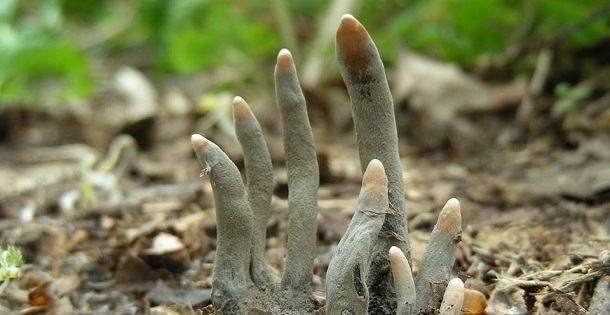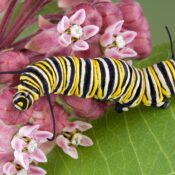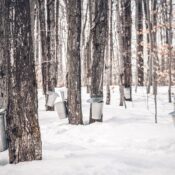Toadstools can make for a spooky sighting. These eldritch fungi are nature’s Halloween decorations. (Warning: pictures of stomach-turning fungus ahead.)
- 1. Bleeding Tooth (Hydnellum peckii)

Photo by H. Krisp The “Bleeding Tooth” mushroom is a niche nightmare for dental hygienists. The early stages of the fruiting bodies, or the mushroom caps, ooze a red liquid. They are found among conifer needles in North America and Europe. Resist the urge to pop this one into your mouth; though it isn’t toxic, the Hydnellum peckii is not a sweet tooth.
2. Devil’s Fingers (Clathrus archeri)

Photo by Bernard Spragg Resembling an evil octopus rising from the underworld to claim a victim, the “Devil’s Fingers” mushroom spawns from a sort of gelatinous egg and produces a rotting smell. Its fruiting body fans out like tentacles with maturity.
3. Jew’s Ear (Auricularia auricula)
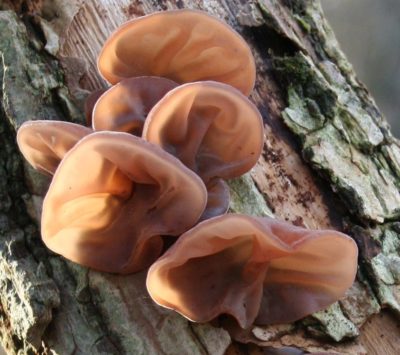
Photo by Svdmolen When a tree falls in a forest, it does make a sound, because this mushroom hears it. The “Wood Ear” or “Jew’s Ear” fungus grows on the elder tree. Apart from its striking resemblance to the human ear, the mushroom was named after Judas Iscariot, who was said to have hung himself from an elder. The aural fungus was thought to be a manifestation of Judas’ spirit.
4. Ophiocordyceps

Photo by Steve Axford at Mushroom Observer This genus of “zombie fungi” are parasites of insects, infecting a host bug and controlling its behavior to benefit the mushroom. The Ophiocordyceps release a chemical into the insect’s brain that hijacks its nervous system, causing it to move with unusual, jerky movements. The fungus directs the bug upwards and bids it to bite into some sort of stem. From there, a fruiting body will emerge from the insect to release more spores for its zombie army.
5. Lattice Stinkhorn (Clathrus ruber)

Photo by Biusch Much like its monstrous cousin, Devil’s Fingers, the Lattice Stinkhorn mushroom grows from an egglike sac. The “eggs” have been cooked and eaten in some cultures, although the mature mushroom reportedly causes sickness when ingested.
6. Rhodotus
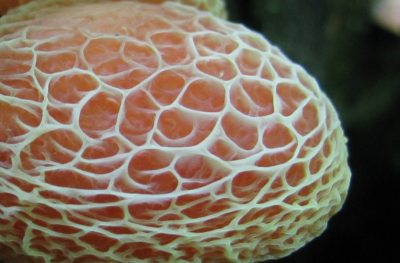
Photo by Dan Molter The netted, veiny appearance of Rhodotus fungi is appalling or winsome, depending upon one’s tolerance for fleshlike mushrooms. In any case, the genus is considered endangered or extinct in several European countries. Hungary even enforces fines for destroying these extraterrestrial toadstools.
7. Ascocoryne sarcoides

Photo by Daryl Thompson at Mushroom Observer No, those aren’t entrails; it’s just a cluster of Ascocoryne sarcoides, or Jelly Drop mushrooms. Studies have suggested a Jelly Drop presence in boreal forests of North America and Europe coincide with fewer harmful fungal infections, specifically in the black spruce.
8. Podostroma cornu-damae
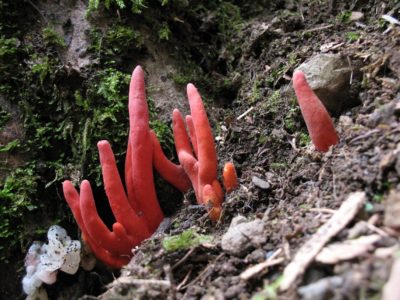
Photo by Kouchan The appearance of this Japanese mushroom is playful and, perhaps, inviting, but the Podostroma cornu-damae is a highly toxic species that causes brutal and idiosyncratic symptoms. Patients who ingest this mushroom — often mistaking it for another — mostly perish within a few days from complications involving skin tissue, bone marrow, and blood toxicity. Best to leave this coral-looking fungus alone.
9. Dead Man’s Fingers (Xylaria polymorpha)

- These boney digits will grab your ankles if you stray too far into the woods. Probably not, in actuality, but the aptly named “Dead Man’s Fingers” appear to be a dusty zombie defying the grave. They are the fruiting bodies of Xylaria polymorpha, a saprobic fungus that only grows on dead trees and roots. Incidentally, young specimens are reportedly edible if you desire a secret ingredient for your next witch’s brew.
Become a Saturday Evening Post member and enjoy unlimited access. Subscribe now
